HP Folio 13 Review: Deviating From the Norm
by Dustin Sklavos on April 17, 2012 12:30 AM EST- Posted in
- Laptops
- Intel
- HP
- Sandy Bridge
- Ultrabook
System Performance
By opting to employ an Intel Core i5 instead of Core i7 (ULV, of course), and then only operating the DDR3 in single-channel mode, HP puts the Folio 13 at a bit of a disadvantage compared to the competition. The Toshiba Portege Z830 is the only one that really has things worse off, but it's also the least expensive of the lot. Here's how the performance charts pan out:
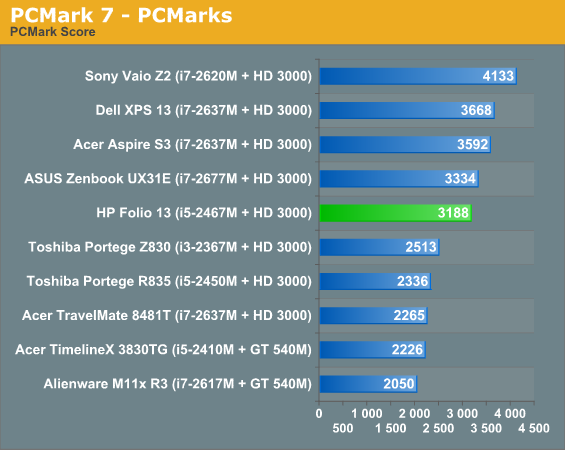
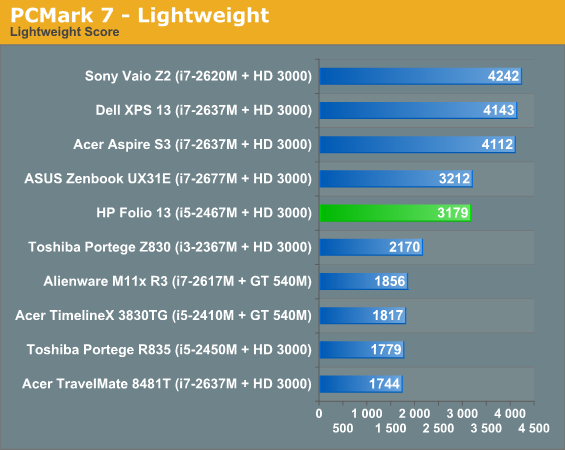
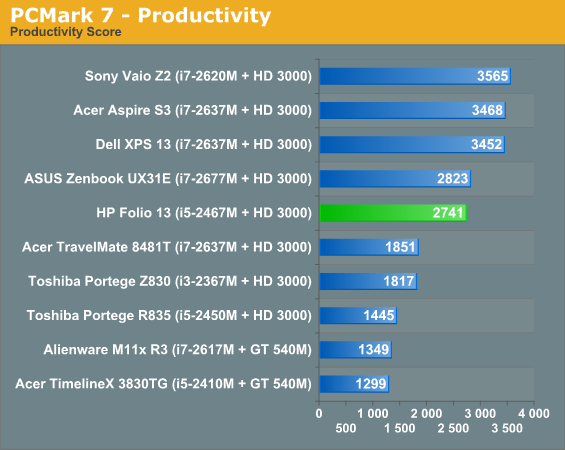
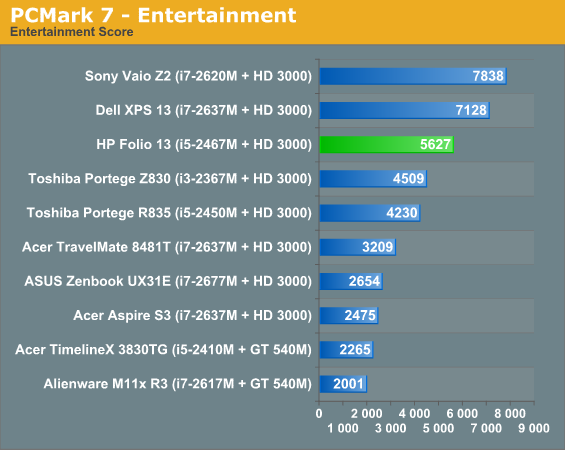
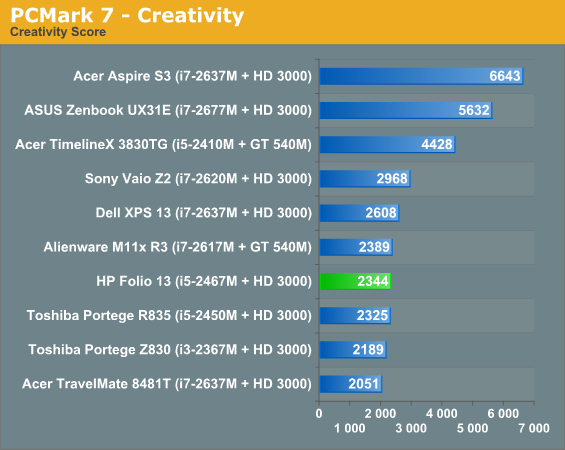

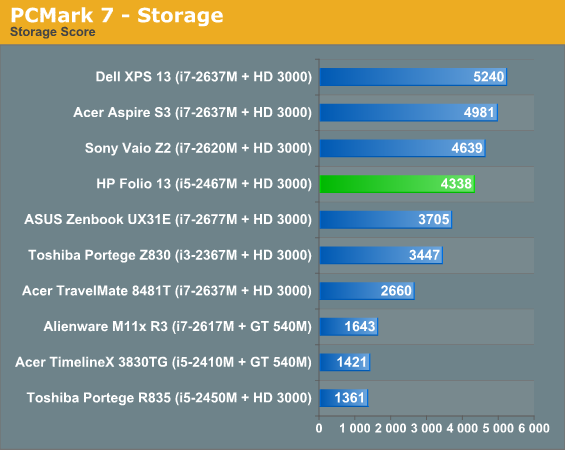

Ultimately the Folio 13 bounces around the middle of our PCMark charts, buoyed somewhat by the decent Samsung SSD included. You can certainly make the case that all of the above systems are "fast enough" for most users, and the SSDs in the ultrabooks definitely help in that regard. As long as you're not doing any heavy number crunching or trying to play games, ULV Sandy Bridge is likely more than sufficient.

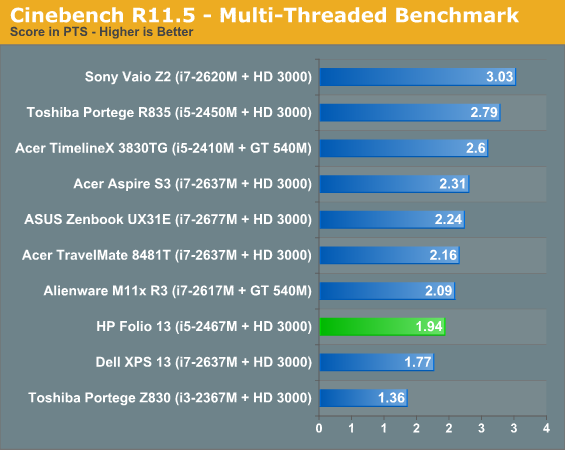
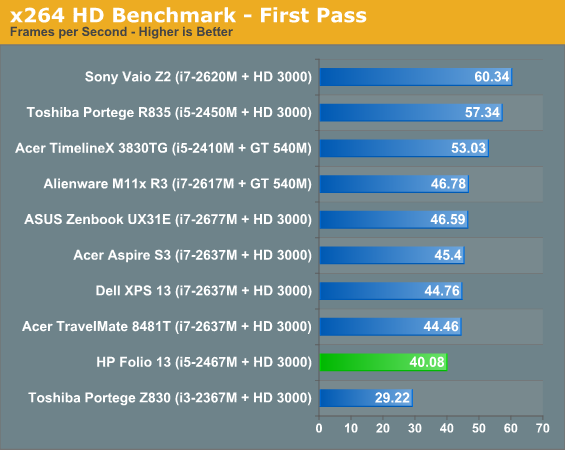
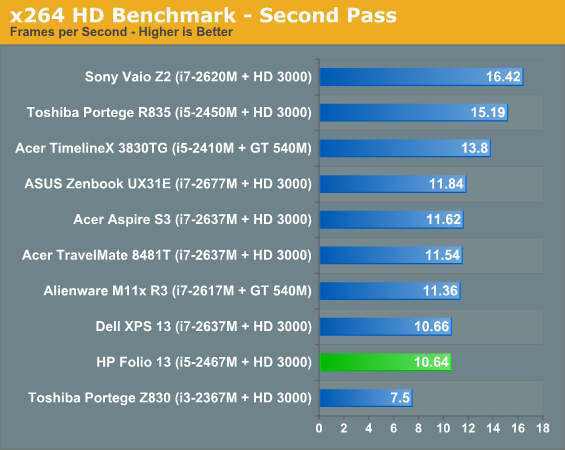
Unfortunately, once we get to the CPU-isolated tests, the Folio 13's i5 gets absolutely buried, only really able to best the Toshiba Portege Z830's i3. The difference between the two is wide enough to make the i3's lack of turbo boost felt, but the i7 systems almost all put in stronger showings across the board with the exception of the Dell XPS 13, which may be struggling with thermal limitations. If we ignore the full-voltage CPUs, the difference between the i5-2467M and the fastest i7-2677M ranges from as little as 11% in the second pass of our x264 test to as much as 28% in our single-threaded Cinebench result. That's certainly noticeable, but it may not be worth the added cost--HP obviously felt the i5-2467M was a good balancing point, since they didn't bother to support any of the other ULV chips.
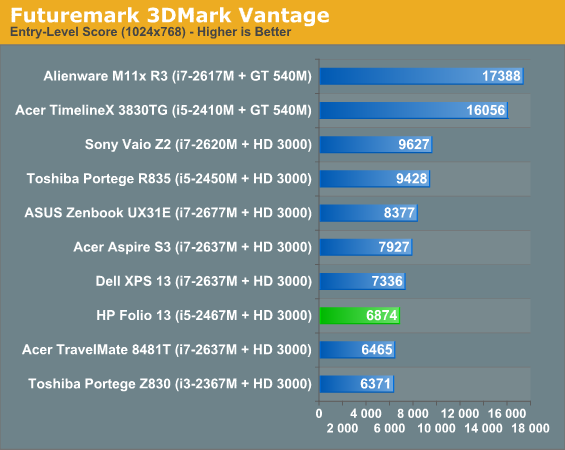
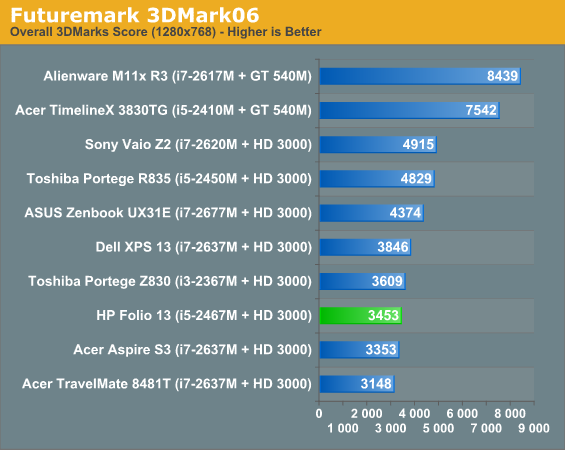
3DMark once again reminds us that these aren't gaming machines; the thin-and-lights equipped with dedicated graphics fare worlds better. Llano likewise easily surpasses the ULV HD 3000, and in fact outside of single-threaded performance the quad-core Llano chips generally offer comparable to superior performance; of course, getting Llano into an ultrabook form factor with an SSD would require some changes to the design and pricing strategry for such laptops.










88 Comments
View All Comments
LordConrad - Wednesday, April 18, 2012 - link
If laptop makers decide to include higher resolution screens by default, I hope there is an option to downgrade. If the native resolution on my 15 inch laptop was any smaller than 768p, I would have trouble reading it.cbf - Wednesday, April 18, 2012 - link
Go the Windows control panel and increase the point size of your text.A5 - Tuesday, April 17, 2012 - link
Thin & light always has and always will cost more. It requires more R&D effort to fit all this stuff in a small enclosure.sigmatau - Tuesday, April 17, 2012 - link
The R&D to creating this case was so high that manufacturers need to charge a $550 premium over a regular laptop?Really? $550 for a thinner case with the same hardware?
JarredWalton - Tuesday, April 17, 2012 - link
Way to just pull a random number out of your hat. Where do you get $550 from? The lowest sale price of a Core i3 laptop, perhaps? Let me give you a rundown of estimated costs (give or take):i5 ULV CPU: $125 (for an OEM?)
RAM: $25
Custom motherboard: $100
128GB SSD: $100 (for an OEM)
LCD: $65
OS: $50 (OEM price?)
Chassis: $150
Keyboard: $25
Touchpad: $10
Bill of Materials alone, then, I'd estimate at $650 give or take, which is $200 higher than what you're estimating. Now, add in additional R&D costs of $200 to design and mass produce a higher quality (e.g. not injection molded plastic) laptop, and then the profit is looking more like $150. If they sell a ton of these, then the R&D costs are covered and they could conceivably get the price down as low as $700 (on sale), but I wouldn't expect anything lower than that.
ImSpartacus - Tuesday, April 17, 2012 - link
How do you know that? I don't mean to question your BoM, I know it's a rough estimate. I'm just curious as to where one could find that sort of information.I thought it was neat when Mr. Sklavos mentioned the cost of LCD panels (http://www.anandtech.com/show/5717/toshiba-portege... It felt like a natural addition to the article that strengthened his point. And it made those LCD rants easier to read, but that's another story...
Anyway, I know you guys are super busy, but it would be pretty sweet if reviews and stuff referenced material costs if it didn't make the review read poorly.
JarredWalton - Wednesday, April 18, 2012 - link
Actually, I'm the editor of Dustin's articles -- I started adding the LCD pricing comments. :-) Which just makes the issue of low quality panels far more frustrating to me. I'm still working on an article on the topic, but ran into a few snags....The real difficulty with the above pricing is that without actually knowing how much OEMs get charged for some parts, I'm left to go off other sources. I can find some components on the open market, so I can quote those prices (e.g. LCDs, SSDs, CPUs), but what you or I would pay to buy the part is almost certainly quite a bit more than what a large OEM would pay for buying in volume. If you were to buy the equivalent components on your own, prices would be up probably $100 at least from my estimates. Mostly it was a list to point out a reasonable BoM for this laptop.
Super56K - Wednesday, April 18, 2012 - link
If only they played by those rules as far as BoM costs. I'd love to pay an extra ~$50 for a 900p 13" screen. But instead they nail us with a 'premium' upgrade option (if they even give you the option)Even on my 15" HP Probook a 1080p screen upgrade, with a new video cable, is around $100-110 to purchase myself. I'd have gladly paid $500 instead of $380 for it with its 768p screen. Ah well, I'm counting down the months until I decide to void my warranty and 'fix' it myself.
kmmatney - Tuesday, April 17, 2012 - link
I was hoping this meant a 16:10 screen...Oderdigg - Tuesday, April 17, 2012 - link
Really?2nd Gen i5, 4GB, 128 SSD, keyboard backlight, USB 3.0, 1GB NIC and 802.11b/g/n. If they had an i7 or an LED panel, it wouldn't be $1000 anymore. It's also very cool to the touch even under duress so there's a good amount of R&D involved.
I just wish it had a better panel, otherwise it's great.